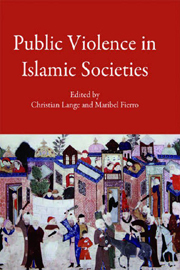 Public Violence in Islamic Societies
Public Violence in Islamic Societies Book contents
- Frontmatter
- Contents
- List of abbreviations
- Acknowledgements
- Introduction: Spatial, ritual and representational aspects of public violence in Islamic societies (7th–19th centuries ce)
- PART I Public violence and the construction of the public sphere
- PART II Ritual dimensions of violence
- PART III Representations of public violence
- 9 Responses to crucifixion in the Islamic world (1st–7th/7th–13th centuries)
- 10 Violence and the prince: the case of the Aghlabid Amīr Ibrāhīm II (261–89/875–902)
- 11 Concepts of justice and the catalogue of punishments under the Sultans of Delhi (7th–8th/13th–14th centuries)
- 12 Public violence, state legitimacy: the Iqāmat al-ḥudūd and the sacred state
- 13 Violence in Islamic societies through the eyes of non-Muslim travellers: Morocco in the 19th and early 20th centuries
- Index
10 - Violence and the prince: the case of the Aghlabid Amīr Ibrāhīm II (261–89/875–902)
from PART III - Representations of public violence
Published online by Cambridge University Press: 12 September 2012
- Frontmatter
- Contents
- List of abbreviations
- Acknowledgements
- Introduction: Spatial, ritual and representational aspects of public violence in Islamic societies (7th–19th centuries ce)
- PART I Public violence and the construction of the public sphere
- PART II Ritual dimensions of violence
- PART III Representations of public violence
- 9 Responses to crucifixion in the Islamic world (1st–7th/7th–13th centuries)
- 10 Violence and the prince: the case of the Aghlabid Amīr Ibrāhīm II (261–89/875–902)
- 11 Concepts of justice and the catalogue of punishments under the Sultans of Delhi (7th–8th/13th–14th centuries)
- 12 Public violence, state legitimacy: the Iqāmat al-ḥudūd and the sacred state
- 13 Violence in Islamic societies through the eyes of non-Muslim travellers: Morocco in the 19th and early 20th centuries
- Index
Summary
The issue of public violence and its use is fundamental when defining the rules which govern the business of politics and which characterize any political regime; for it is closely linked to the nature of tyranny and the definition of the common good. In contrast to essentialist concepts which would lead one to see the Muslim world as being inherently violent, particularly when dealing with politics and the exercise of power, there is a need to try to write a history of public violence, its uses and its perceptions in the Muslim world, for which we currently lack any precise analysis. This study seeks to make a timely contribution to that vital effort of collective reflection.
The case of Ibrāhīm II, one of the last Aghlabid amīrs (261–89/875–902) before the accession of the Fāṭimids in Ifrīqiya, has always been considered extreme in this regard. His example enables us to outline the concepts developed by chroniclers concerning the violence of the prince, which is one of the facets of public violence. Paradoxically, because Ibrāhīm II is a borderline case (or at least is presented as such by medieval sources), his figure serves better than any other to comprehend public violence in late 3rd/9th-century Ifrīqiya as well as to understand the limits which could not be overstepped in this respect. It clearly shows that the unlimited use of public violence is not an essential and atemporal feature of Islam, and that it is readily criticized, among others by Arabo-Islamic chroniclers.
- Type
- Chapter
- Information
- Public Violence in Islamic SocietiesPower, Discipline, and the Construction of the Public Sphere, 7th-19th Centuries CE, pp. 217 - 237Publisher: Edinburgh University PressPrint publication year: 2009


